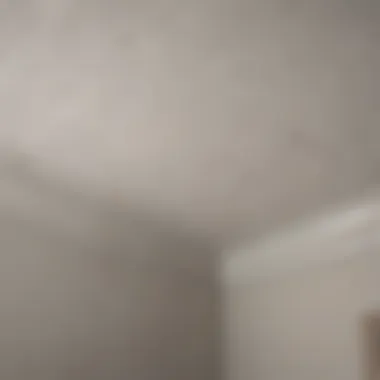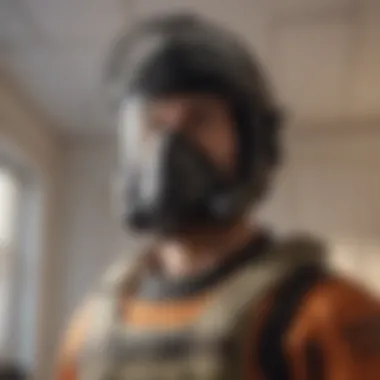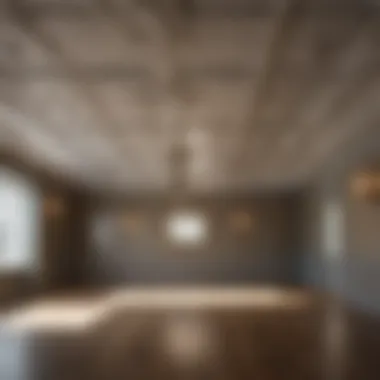Materials:
To begin this DIY project of removing popcorn ceiling, gather the following essential materials: a mask to protect your lungs from dust inhalation, safety goggles to shield your eyes, a step ladder for reaching higher areas, a large drop cloth to cover and protect the floor, a garden sprayer containing water for spraying the ceiling, a wide scraper or drywall knife for scraping off the popcorn texture, and a bucket for collecting the scraped material.
DIY Steps:
Now, let's delve into the step-by-step instructions for effectively removing popcorn ceiling:
- Preparation: Start by preparing the room, removing all furniture and covering everything with the drop cloth to prevent any damage.
- Moistening the Ceiling: Fill the garden sprayer with water and lightly spray a small section of the ceiling to moisten the popcorn texture.
- Scraping: Utilize the scraper or drywall knife to gently scrape off the wet popcorn texture, working in small sections to avoid over-soaking the ceiling.
- Cleanup: Dispose of the scraped material in the bucket and continue the process until the entire ceiling is free of the popcorn texture.
- Final Touches: Once the ceiling is smooth, allow it to dry completely before considering any further finishing touches or repaints.
Technical Aspects:
In terms of technical aspects, it is crucial to pay attention to the following tools and techniques for a successful popcorn ceiling removal:
- Timing: Ensure you allocate sufficient time for each stage of the process, allowing for drying time between moistening and scraping.
- Techniques: Employ smooth and deliberate scraping motions to avoid damaging the ceiling beneath.
- Safety: Prioritize safety by wearing protective gear and ensuring the room is well-ventilated during the removal process.
DIY Project Process:


The sequential steps involved in removing popcorn ceiling are meticulous and precise, requiring attention to detail and patience. By following the outlined materials and steps carefully, you can achieve a smooth and renovated ceiling without the textured finish.
Troubleshooting Tips:


Common issues that may arise during the popcorn ceiling removal process include uneven scraping, excess moisture, or difficulty in removing stubborn areas. To troubleshoot these problems, adjust the scraping pressure, allow for proper drying time, or consider reapplying water to challenging sections. Remember, perseverance is key to achieving a flawless result in this DIY project.
Prologue


Popcorn ceiling removal is a critical home improvement task that enhances the aesthetic appeal and may offer health benefits. Understanding the intricacies of dealing with textured ceilings is vital to the success of this project. From composition to removal techniques, each aspect plays a pivotal role in achieving a smooth and polished ceiling finish, elevating the overall look of your living space.
Understanding Popcorn Ceiling
Popcorn ceilings, also known as acoustic ceilings, are textured finishes utilized in homes for various reasons. The composition of popcorn ceiling typically includes materials like styrofoam or vermiculite. These components contribute to the distinctive popcorn texture, known for its sound-absorbing qualities and ability to hide imperfections. Despite its popularity in the past, removing popcorn ceiling is now a common practice due to its outdated appearance and potential health risks associated with asbestos.
Composition of Popcorn Ceiling
The key characteristic of popcorn ceiling composition lies in its ability to provide acoustic insulation and a unique texture that diffuses sound. This feature made it a popular choice in older homes. However, the downside of popcorn ceiling composition is its potential to contain asbestos, a hazardous material requiring professional removal.
Reasons for Removing Popcorn Ceiling
The decision to remove popcorn ceiling is often motivated by its outdated appearance, which can detract from a modern interior. Additionally, the presence of asbestos in older ceiling installations poses health risks, prompting homeowners to opt for removal for safety reasons. Addressing these concerns is crucial in creating a safe and aesthetically pleasing living environment.
Considerations Before Removal
Before embarking on popcorn ceiling removal, several essential considerations must be addressed to ensure a smooth and safe process. Safety precautions and environmental impact play significant roles in executing this task effectively.
Safety Precautions
Safety precautions are paramount during popcorn ceiling removal due to the potential hazards of asbestos exposure and falling debris. Wearing protective gear, such as masks and goggles, is crucial to minimize health risks. Proper ventilation and sealing off the workspace can mitigate the spread of dust and debris, promoting a safe working environment.
Environmental Impact
The environmental impact of popcorn ceiling removal extends to proper disposal practices and potential air quality concerns. Minimizing dust exposure and ensuring thorough cleanup are essential for safeguarding indoor air quality. Considering eco-friendly disposal methods and materials can further reduce the environmental footprint of the removal process.
Tools and Materials
An array of tools and materials are essential for efficiently removing popcorn ceiling. Equipping yourself with the right resources can streamline the process and ensure a successful outcome.
List of Essential Tools
In your arsenal, include tools such as a ceiling scraper, ladder, drop cloths, and a spray bottle for effective removal. These tools are instrumental in scraping off the textured finish and preparing the ceiling for refinishing.
Materials Needed
Materials like water, plastic sheeting, and trash bags are indispensable for containing debris and facilitating cleanup. Additionally, investing in asbestos testing kits can provide peace of mind before commencing the removal process. Gathering all necessary materials beforehand is key to a hassle-free operation.
Methods of Removal
Multiple techniques can be employed to remove popcorn ceiling, each with its distinct advantages and considerations. Understanding these methods is essential to choose the approach that best fits your needs and abilities.
Scraping Technique
The scraping technique involves manually scraping off the textured surface using a specialized tool. This method is labor-intensive but effective in removing the popcorn finish, preparing the ceiling for refinishing.
Cover and Scrape Method
The cover and scrape method entails covering the ceiling with a new layer of drywall or plaster before scraping off the textured finish. This approach minimizes dust and simplifies cleanup, offering a smoother transition to a new ceiling texture.
Using Chemical Solutions
Chemical solutions can be utilized to soften the textured finish, making it easier to scrape off. While convenient, this method requires caution due to chemical exposure risks. Balancing effectiveness with safety measures is crucial when opting for chemical removal solutions.
DIY vs. Professional Assistance
In the realm of removing popcorn ceilings, a crucial decision lies ahead - opting between the personalized touch of a do-it-yourself (DIY) approach or entrusting the project to seasoned professionals. This section carefully dissects the pros and cons of each route, shedding light on essential elements that can influence your decision-making process. Understanding the intricacies of DIY versus professional assistance is vital to ensure a satisfactory outcome.
Pros and Cons of DIY Removal
Cost Considerations:
Delving into the cost considerations of a DIY popcorn ceiling removal project opens a realm of possibilities and challenges. The allure of cost-effectiveness often leads many homeowners towards this path. Despite potential savings, hidden expenses such as specialized tools or refinishing materials may arise, impacting the overall budget. Balancing expenditure with quality results remains a delicate equation in this context, emphasizing the need for meticulous planning and foresight.
Skill and Time Required:
Embarking on a DIY removal journey demands not just monetary investment but a significant allocation of time and skill. The skill and time required to execute this task proficiently should not be underestimated. From careful scraping to ensuring proper disposal, each step necessitates attention to detail and precision. Prospective DIY enthusiasts must gauge their expertise and schedule availability realistically before committing to the removal process.
Benefits of Hiring Professionals
Expertise and Efficiency:
Entrusting the removal of popcorn ceiling to professionals guarantees a level of expertise and efficiency that is hard to replicate. Skilled in the art of ceiling restoration, professionals possess the know-how to navigate complexities seamlessly. Their adeptness at handling diverse challenges ensures a swift and competent removal process, sparing homeowners the burden of potential errors.
Safety and Quality Assurance:
One of the standout advantages of hiring professionals is the assurance of safety and quality in the removal proceedings. With a keen eye for detail and adherence to safety protocols, professionals prioritize health standards and quality outcomes. From asbestos testing to meticulous cleanup, their commitment to excellence extends to every facet of the project, promoting peace of mind for concerned homeowners.
Post-Removal Considerations
As we progress beyond the physical removal of popcorn ceiling, we venture into a critical phase of post-removal considerations. This juncture demands careful attention, as overlooking these elements may result in unforeseen complications down the line. One of the primary focuses during this stage is ceiling repair and refinishing.
Ceiling Repair and Refinishing
In the aftermath of removing the popcorn ceiling, it is essential to address any damage or imperfections that may have occurred during the removal process. This involves meticulously evaluating the ceiling's surface for any irregularities, holes, or cracks that need repairs. The process of patch and paint plays a pivotal role in restoring the ceiling to its former glory.
Patch and Paint
Patch and paint are integral components of the restoration process, offering a seamless solution to cover up imperfections on the ceiling surface. The key characteristic of patch and paint lies in its ability to camouflage any blemishes effectively. Utilizing high-quality patching compounds and paint ensures a durable and visually appealing finish, aligning with the overall goal of achieving a smooth and polished ceiling surface.
Texturing Options
When considering texturing options post-removing popcorn ceiling, it is crucial to explore various textures that can enhance the aesthetic appeal of the ceiling. Different texturing techniques, such as knockdown or orange peel, provide options to cater to individual preferences. Understanding the unique features of each texturing option allows homeowners to choose a finish that aligns with their desired ambiance.
Clean-Up and Disposal
Apart from the cosmetic aspects, the clean-up and disposal phase holds significant importance in the post-removal considerations. Ensuring proper disposal of materials and cleaning up residue left from the removal process is essential for maintaining a safe and clean environment within the home.
Proper Disposal of Materials
Proper disposal of materials involves adhering to regulations for the disposal of debris resulting from the removal process. Following appropriate waste disposal guidelines not only promotes environmental sustainability but also prevents potential health hazards.
Cleaning Up Residue
Thoroughly cleaning up residue left behind from the removal process is crucial to eliminate any remnants of popcorn ceiling material. Effective cleaning methods ensure that the space is ready for subsequent renovation or repurposing without any lingering debris or dust particles.
Inspecting for Asbestos
To conclude the post-removal considerations, conducting thorough inspections for asbestos contamination is imperative. Despite popcorn ceilings being phased out due to asbestos concerns, older properties may still harbor this hazardous material, necessitating cautious testing procedures.
Testing Procedures
Testing procedures for asbestos involve taking samples from the ceiling material and sending them to accredited laboratories for analysis. This step is critical in identifying any traces of asbestos, enabling homeowners to take appropriate measures for mitigation and removal.
Dealing with Asbestos Contamination
In the event of asbestos contamination, specialized experts should handle the removal process to prevent exposure and health risks. Dealing with asbestos contamination demands a systematic approach that prioritizes safety measures and compliance with regulatory protocols.
These intensive post-removal considerations encompass various aspects - from aesthetic refinishing to environmental safety. By meticulously addressing each element, homeowners can transform their living spaces with confidence and peace of mind.
The End
Popcorn ceiling removal is a vital home improvement task that demands careful consideration and planning to achieve optimal results. The conclusion of this guide encapsulates key aspects essential for successfully completing this project. Emphasizing the significance of meticulous ceiling repair and meticulous cleaning post-removal contributes not only to the aesthetics of your living space but also to the safety and well-being of your household. By following the tips provided in this guide, maintaining the integrity of your ceiling and scheduling regular inspections will ensure that your living environment remains pristine and free from any potential hazards.
Final Tips and Recommendations
Maintaining Ceiling Integrity
Maintaining ceiling integrity goes beyond mere aesthetics; it is a foundational aspect crucial for the longevity and safety of your home. This process involves patching up any imperfections, such as cracks or holes, before proceeding with the removal of popcorn ceiling. By ensuring that your ceiling is structurally sound, you are enhancing the overall stability of your living space. The meticulous approach to maintaining ceiling integrity advocated in this article guarantees a durable and secure home environment, free from the risks associated with compromised ceilings.
Regular Inspections
Regular inspections play a pivotal role in preventing potential hazards and maintaining the quality of your ceiling post-removal. By conducting routine checks, you can identify any signs of damage or wear and tear early on, allowing for timely repairs and upkeep. This proactive approach not only ensures the longevity of your ceiling but also safeguards your household against any unforeseen issues. Implementing regular inspections as outlined in this guide offers peace of mind, knowing that your living space is well-maintained and safe for you and your family.





